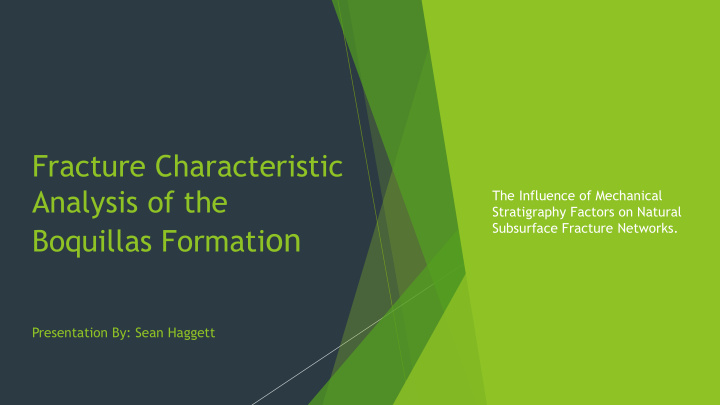



Fracture Characteristic Analysis of the The Influence of Mechanical Stratigraphy Factors on Natural Subsurface Fracture Networks. Boquillas Formati on Presentation By: Sean Haggett
Research Goals Improve subsurface fracture character prediction by identifying mechanical stratographic controls on natural fracture spacing and penetration. Identify controls on inter-bed boundary fracture propagation in fine-grained sedimentary hydrocarbon reservoir rocks (mudrock) Derive information from exposed outcrops regarding formation conditions that will constrain fracture characteristics Isolate influences of individual factors Bed thickness Mechanical properties of the layer Formation environment
Location: The Ernst Tinaja Tinaja – term for bedrock depressions carved by stream flow and scouring by intermittent streams. (arroyos) Exposes the Ernst Member of the Boquillas Formation in Big Bend National Park west Texas. Tests conducted on exposed bedding to asses the permeability of mechanical strata
Ernst Member: Why Here? Experienced two co-directional tectonic events 1. NE-SW contraction – Laramide Orogeny (70 – 50 MA) 2. NE-SW extension – Basin and Range tectonics (25 – 2 MA) Back-arc extension created opening- mode fractures throughout the strata
Ernst Member Deep marine, pelagic succession Mudrock Chalk Limestone Volcanic ash Mostly gradation bedding contacts (slow transition deposition) Some abrupt/sharp transitions between beds (storm activity winnowed surface, quick transition) These different boundary contacts were perfect for the study.
Methods Defining Mechanical Stratigraphy: need to quantify… 1. Material properties of rock strata (i.e. competency / comprehensive and tensile strengths) 2. Thickness of mechanical layers (direct measurement) 3. Character of friction properties between layers (i.e. sharp/abrupt vs. gradation boundaries
Methods: Scanlines Taken under specific conditions 1. Conducted parallel to dip along center of the bed. 2. Locations far from large folds or faults to reduce influence of large structural extension 3. Fractures intersecting scanlines measures from center for – strike/dip, trace length, penetration distance, and fracture spacing
Methods: N-Type Schmidt Hammer Measuring mechanical rebound – R Used to characterize relative competency by assigning each layer a measured cohesive strength Procedure – 1. Ten readings in a 25cm² area 2. R values of 20 – 50 correspond to cohesive strengths of 5 – 40 Mpa 3. Higher the rebound = Higher the competency
Methods: X-Ray Diffraction Used to determine clay mineral component of the strata Competency controlled by percent clay composition (i.e. higher %clay = lower competency) Test results: Mudrock = 15 – 90% clay minerals Limestone & Chalk = 0 -12% clay minerals Competency of Limestone/Chalk > Mudrock
Results 1: Inverse correlation between percent clay and rebound (i.e. More clay = Less competent) Two distinct regions corresponding to high competency Limestone & Chalk (R = 25-55) and low competency Mudrock (R = >10-12) Samples with >15% clay have lower average rebound, samples with <12% clay have rebound values greater than 24 Determined Limestone & Chalk are most competent layers
Results 2 Inverse correlation between comprehensive strength and mean layer thickness (i.e. thinner layer on avg. = more competent) Mean R Values compared to percent of total number of beds within certain thicknesses. 57% mudrock beds thicker than 0.2m 40% chalk beds thicker than 0.2m 20% limestone beds thicker than 0.2m i.e. limestone and chalk have on average thinner beds with higher competency, mudrock has thick beds with low competency.
Results 3 Overwhelming majority of fractures were opening- mode extension and had N-NW strike and bed- perpendicular dip Stereonets depict relatively uniform fracture behavior throughout the stratographic column. Fracture dips tended to be lower in mudrocks and higher in chalk and limestone
Results 4 Positive correlation between mean fracture spacing and bed thickness (i.e. greater bed thickness = greater fracture spacing) Mean fracture spacing/bed width tended to increase with higher rebound values (i.e. higher rebound values = greater spacing/thickness ratio) Limestone & chalk – spacing/thickness ratio = 0.9, 0.8 Mudrock – spacing/thickness ratio = 0.17
Results 5 Fractures within limestone & chalk commonly penetrate the full bed as well as adjacent mudrock. Fractures within mudrock do not penetrate into carbonate rock layers Mudrock = Top bounded Limestone & Chalk = Bed bounded and Unbounded Means that mudrock fractures do not penetrate into overlaying material due to discontinuities between sharp bed transition as a result of surface storm activity, whereas gradually deposited (limestone to mudstone) sediment boundaries are more continuous and allow for fracture propagation
Conclusions Lithology and mechanical bed character have a strong influence on bed-parallel spacing and bed-perpendicular penetration of fractures Limestones and Chalk beds Strong correlation between bed thickness and fracture spacing Fractures penetrate adjacent mudrock beds due to gradual transitions caused by steady sediment deposition Mudrock beds Poor correlation between bed thickness and fracture spacing Fractures terminate within mudrock beds due to abrupt bed transitions caused by storm winnowing Overall natural fracture connectivity through the mechanically layered Ernst Member sequence generally deemed poor. Hydraulic fracturing likely to reactivate and link natural fracture networks, cause for concern regarding groundwater contamination.
Article Citation McGinnis, Ronald N., David A. Ferrill, et al. “Mechanical stratigraphic controls on natural fracture spacing and penetration”. Journal of Structural Geology 95 (2017) p.160 -170 Elsevier Web Thur. 6 Dec. 2018
Recommend
More recommend